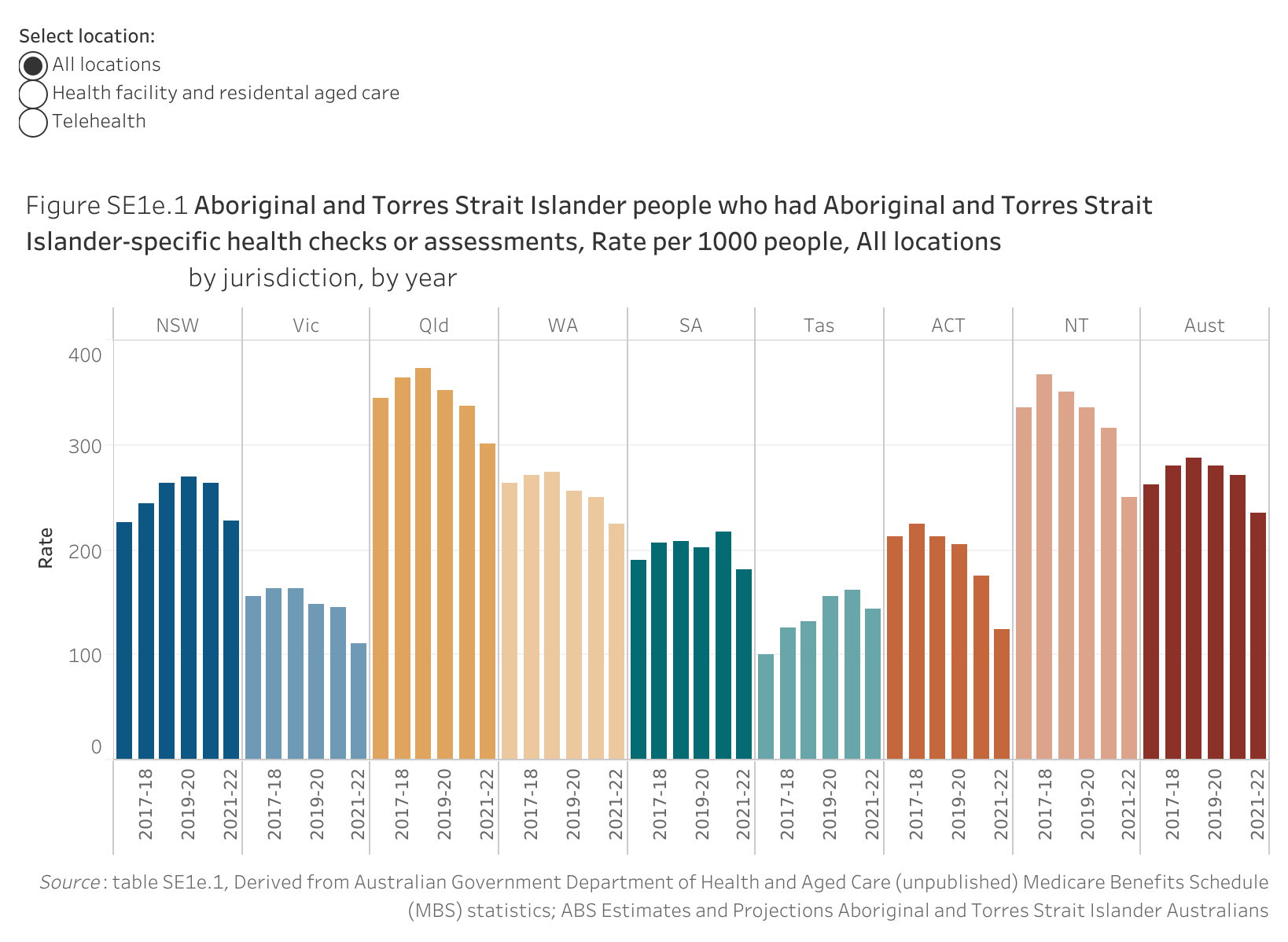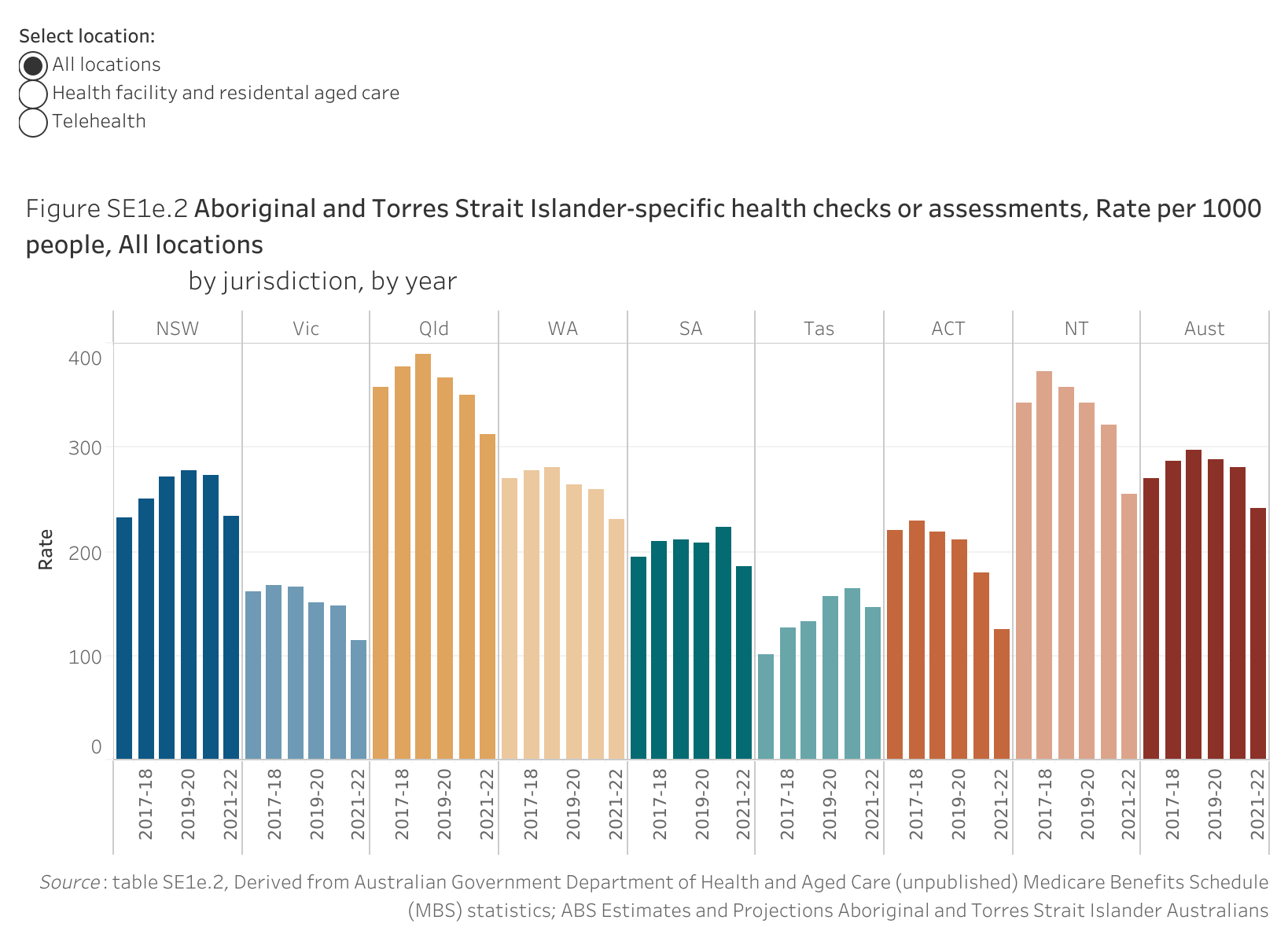Driver
Rates of accessing/utilisation of health services
General Practitioner (GP) visits, health assessments (Medicare Benefit 715), chronic disease care items (Team Care arrangement and GP Management Plan)
Dashboard snapshot: The data below are the most recent at the time of preparing the July 2023 report. Please go to the dashboard to access the current data.
Measure 1
Rate of GP visits
Data for this measure are not currently available. See the Indicator data specification below for further information.
Measure 2
Rate of people who had Aboriginal and Torres Strait Islander-specific health checks or assessments, by location of assessment
Nationally in 2021-22, 235.0 per 1000 Aboriginal and Torres Strait Islander people (just under 1 in 4) had Indigenous-specific health checks or assessments. This rate is the lowest for the six years of reported data and reflects a continuing decrease since the peak in 2018-19 (287.7 per 1000 people) (figure SE1e.1). Nationally in 2021-22, Aboriginal and Torres Strait Islander people mainly received Indigenous-specific health checks or assessments at health facilities or residential aged care (98 per cent), with 2 per cent obtaining checks via telehealth (table SE1e.1)

| Year | NSW | Vic | Qld | WA | SA | Tas | ACT | NT | Aust |
|---|---|---|---|---|---|---|---|---|---|
| 2016-17 | 226.0 | 156.0 | 345.3 | 263.6 | 190.3 | 100.1 | 212.7 | 335.7 | 262.3 |
| 2017-18 | 244.4 | 163.3 | 363.6 | 271.7 | 206.6 | 125.9 | 224.5 | 366.3 | 279.7 |
| 2018-19 | 263.3 | 162.7 | 373.7 | 273.5 | 207.5 | 132.4 | 212.9 | 350.4 | 287.7 |
| 2019-20 | 269.5 | 148.1 | 352.1 | 256.3 | 202.5 | 155.4 | 205.0 | 335.8 | 279.6 |
| 2020-21 | 264.4 | 145.8 | 337.4 | 250.8 | 216.8 | 161.9 | 174.9 | 316.8 | 271.9 |
| 2021-22 | 228.2 | 111.6 | 301.3 | 224.4 | 181.0 | 144.1 | 123.9 | 250.3 | 235.0 |
Measure 3
Rate of Aboriginal and Torres Strait Islander-specific health checks or assessments, by location of assessment
Nationally in 2021-22, there were 242.1 Aboriginal and Torres Strait Islander-specific health checks or assessments per 1000 people. This rate is the lowest for the six years of reported data and reflects a continuing decrease since the peak in 2018-19 (297.3 per 1000 people) (figure SE1e.2). Nationally in 2021-22 Aboriginal and Torres Strait Islander people mainly received Indigenous-specific health checks or assessments at health facilities or residential aged care (98 per cent), with 2 per cent obtaining checks via telehealth (table SE1e.2).

| Year | NSW | Vic | Qld | WA | SA | Tas | ACT | NT | Aust |
|---|---|---|---|---|---|---|---|---|---|
| 2016-17 | 231.9 | 160.8 | 358.1 | 270.6 | 195.4 | 101.0 | 220.2 | 342.5 | 270.1 |
| 2017-18 | 250.7 | 166.9 | 376.8 | 277.8 | 210.3 | 126.7 | 228.7 | 372.6 | 287.5 |
| 2018-19 | 272.0 | 165.6 | 389.6 | 281.1 | 211.9 | 133.4 | 219.5 | 357.3 | 297.3 |
| 2019-20 | 278.3 | 150.8 | 366.2 | 264.2 | 207.8 | 157.7 | 211.7 | 342.8 | 288.8 |
| 2020-21 | 273.0 | 148.6 | 349.8 | 259.1 | 223.0 | 164.8 | 179.2 | 322.0 | 280.6 |
| 2021-22 | 234.7 | 114.0 | 312.1 | 231.6 | 186.2 | 146.0 | 126.0 | 254.9 | 242.1 |
Measure 4
Rate of chronic disease care items (under Team Care Arrangements and GP Management Plans)
Data for this measure are not currently available. See the Indicator data specification below for further information.
Indicator data specifications
Related Outcome: | Aboriginal and Torres Strait Islander people enjoy long and healthy lives. |
|---|---|
Related target: | Close the Gap in life expectancy within a generation, by 2031. |
Indicator: | Rates of accessing/utilisation of health services (General practitioner (GP) visits, health assessments (Medicare Benefit 715), chronic disease care items (Team Care arrangement and GP management plan)) |
Measures: | There are four measures for this indicator. Measure 1 is the rate of GP visits, defined as: Numerator — number of non-referred GP services for Aboriginal and Torres Strait Islander people Denominator — number of Aboriginal and Torres Strait Islander people and is presented as a rate per 1000 people. Measure 2 is the rate of Aboriginal and Torres Strait Islander people who had Aboriginal and Torres Strait Islander-specific health checks or assessments, by assessment locations (health facility and residential aged care, and telehealth), defined as: Numerator — number of Aboriginal and Torres Strait Islander people who had MBS health checks/assessments that are Aboriginal and Torres Strait Islander-specific (MBS items 715, 228, 92004, 92016, 93470, 92011, 92023, 93479), by assessment locations Denominator — number of Aboriginal and Torres Strait Islander people and is presented as a rate per 1000 people. Measure 3 is the rate of Aboriginal and Torres Strait Islander-specific health checks or assessments, by location of assessment (health facility and residential aged care, and telehealth), defined as: Numerator — number of MBS health checks/assessments that are Aboriginal and Torres Strait Islander-specific (MBS items 715, 228, 92004, 92016, 93470, 92011, 92023, 93479), by location of assessment Denominator — number of Aboriginal and Torres Strait Islander people and is presented as a rate per 1000 people. Measure 4 is the rate of chronic disease care items (under Team Care Arrangements (TCAs) and GP Management Plans (GPMPs), defined as: Numerator — number of MBS services claimed by Aboriginal and Torres Strait Islander people (separately for TCAs and GPMPs) Denominator — number of Aboriginal and Torres Strait Islander people and is presented as a rate per 1000 people. |
Indicator established: | National Agreement on Closing the Gap July 2020 |
Latest dashboard update for the indicator: | 8 March 2023 |
Indicator type: | Driver |
Interpretation of change: | For all measures, a high or increasing proportion is generally desirable as indicates greater access to services, but access to services should be considered in the context of population need. |
Data source(s): | Numerator (all measures) Name: Medicare data Frequency: Annual (revised data for 2016-17 to 2020-21 included in the March 2023 Dashboard update – see Data quality considerations for further information) Documentation (links): http://www.mbsonline.gov.au/internet/mbsonline/publishing.nsf/Content/Home Denominator (all measures) Name: Estimates and projections for Aboriginal and Torres Strait Islander Australians Frequency: Annual (data revised on a five-yearly basis) |
Data provider: | Numerator (measures 1 and 4) Data are not currently available. Numerator (measures 2 and 3) Provider name: Department of Health Provider area: MBS Analytics Section Denominator (all measures) Provider name: Australian Bureau of Statistics Provider area: Demography |
Baseline year: | Measures 1 and 4 Data not available for reporting against these measures (see Future Reporting below for further information). Measures 2 and 3 2016-17 |
Latest reporting period: | Measures 1 and 4 Data not available for reporting against these measures (see Future Reporting below for further information). Measures 2 and 3 2021-22 |
Disaggregations: | Measures 1 and 4 Data not available for reporting against these measures (see Future Reporting below for further information). Measures 2 and 3 State and territory and Australia, by location of assessment |
Computation: | Measures 2 and 3 Numerator divided by Denominator multiplied by 1000 The MBS data does not include services:
Counting rules The reference period is the Date-of-Service (DOS), using data processed to June the following year. Any claims processed after the following financial year are not counted. For example, for 2016-17 any claims processed after 30 June 2018 and provided during 2016-17 have not been counted. Data by geographic location is based on the patient’s geographic location which is determined using their Medicare enrolment address at the DOS. Unallocated patients are included in the Australian total. GP services are episodes of care and include both physical visits and telehealth services. Measure 2 Counts of people are reported for the following locations:
As a person can have multiple assessments at different assessment locations in a given year, the sum of people across assessment locations may be greater than the total number of Aboriginal and Torres Strait Islander people who had health checks or assessments. Measure 3 Subtotals are reported by location of health assessment: health facility, telehealth and residential aged care. Denominator (measures 2 and 3): Estimated population as at 31 December:
|
Data quality considerations: | MBS data do not give a comprehensive picture of actual service delivery for Aboriginal and Torres Strait Islander people, as some service delivery (particularly in remote areas) is not covered fully under the Medicare system. For example, MBS data do not include services provided in the public health system or under other arrangements that do not attract an MBS claim (for example, some Aboriginal Medical Services/ACCHOs and state/territory health services). In the March 2023 update, data were revised for NT, SA and WA. The revision affected the geographic distribution of a portion of patients and does not affect the total for Australia. The Aboriginal and Torres Strait Islander-specific Residential Aged Care Facility (RACF) items began in 2020-21 and do not have enough volume to be reported on their own so these are combined with the Health facility items from that reporting year. Prior to 10 December 2020, Aboriginal and Torres Strait Islander people in RACFs had been able to access non-Indigenous specific health assessments performed by GPs and other medical professionals. |
Future reporting: | Data for measures 1 and 4 are planned for reporting as part of the next Dashboard update, using weighted-VII data provided by the Australian Institute of Health and Welfare. This will be revised once the Commonwealth Department of Health approve the Health and Aged Care Indigenous Identifier (HACII) for use. The Department has advised that the method of identifying Indigenous status in Medicare data is currently transitioning from the Voluntary Indigenous Identifier (VII) to the HACII. The Department no longer provides data based on the VII, and the HACII is in the process of clearance consultation and validation and is not anticipated to be finalised in time for data provision for the June 2023 update. Additional disaggregations required for future reporting:
|
